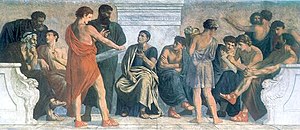What is the history of Education?
float: right;
The history of education is the history of teaching and learning. Each generation, since the beginning of human existence, has sought to pass on cultural and social values, traditions, morality, religion and skills to the next generation.[1] The passing on of culture is also known as enculturation and the learning of social values and behaviours is socialization. The history of the curricula of such education reflects human history itself, the history of knowledge, beliefs, skills and cultures of humanity.[2][3]In pre-literate societies, education was achieved orally and through observation and imitation. The young learned informally from their parents, extended family and grand parents. At later stages of their lives, they received instruction of a more structured and formal nature, imparted by people not necessarily related, in the context of initiation, religion or ritual.[4][5][6]As the customs and knowledge of ancient civilizations became more complex, many skills would have been learned from an experienced person on the job, in animal husbandry, agriculture, fishing, preparation and preservation of food, construction, stone work, metal work, boat building, the making of weapons and defensis, the military skills and many other occupations.Source: http://en.wikipedia.org/wiki/History_of_education
With the development of writing, it became possible for stories, poetry, knowledge, beliefs, and customs to be recorded and passed on more accurately to people out of earshot and to future generations. In many societies, the spread of literacy was slow; orality and illiteracy remained predominant for much of the population for centuries and even millennia.[7] Literacy in preindustrial societies was associated with civil administration, law, long distance trade or commerce, and religion.[8] A formal schooling in literacy was often only available to a small part of the population, either at religious institutions or for the wealthy who could afford to pay for their tutors. The earliest known universities, or places of higher education, started teaching a millennium or more ago.
Universal education of all children in literacy has been a recent development, not occurring in many countries until after 1850 CE. Even today, in some parts of the world, literacy rates are below 60 per cent (for example, in Afghanistan, Pakistan, Bangladesh). Schools, colleges and universities have not been the only methods of formal education and training. Manyprofessions have additional training requirements, and in Europe, from the Middle Ages until recent times, the skills of a trade were not generally learnt in a classroom, but rather by serving an apprenticeship.
Nowadays, formal education consists of systematic instruction, teaching and training by professional teachers. This consists of the application of pedagogy and the development ofcurricula.
For More information Search at Wikipedia.org Our Free Encyclopedia!
Subscribe to:
Post Comments (Atom)









April 6, 2011 at 1:31 AM
A school building was fenced off with barbed wire in Espoo, Finland in 1908 (see the picture in the link). Swedes fenced off school buildings with barbed wire, in order to ban children the access to a school.
The Swedish government was responsible for the most iron ore the Nazis received. Kiruna-Gällivare ore fields in Northern Sweden were all important to Nazi Germany.
These massive deliveries of iron ore and military facilities from Sweden to Nazi Germany lengthened World War II. Casualties of the war have been estimated at 20 million killed in Europe. How many of them died due to Sweden's material support to Nazi Germany, is not known.
http://www.thoughts.com/raimo/case-sweden
Post a Comment